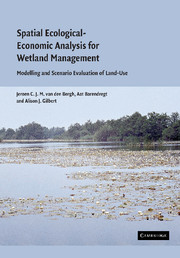 Spatial Ecological-Economic Analysis for Wetland Management
Spatial Ecological-Economic Analysis for Wetland Management Book contents
- Frontmatter
- Contents
- List of figures
- List of tables
- Preface
- 1 Introduction
- 2 Wetlands and science
- 3 Integrated modelling and assessment
- 4 Theoretical framework and method of integrated study
- 5 The Vecht area: history, problems and policy
- 6 Development scenarios for the Vecht area
- 7 The spatial–ecological model: hydrology and ecology
- 8 The spatial–economic model: agriculture, nature conservation and outdoor recreation
- 9 Performance indicators for the evaluation
- 10 Evaluation of the scenarios
- 11 Conclusions: policy and research implications
- References
- Index
10 - Evaluation of the scenarios
Published online by Cambridge University Press: 24 November 2009
- Frontmatter
- Contents
- List of figures
- List of tables
- Preface
- 1 Introduction
- 2 Wetlands and science
- 3 Integrated modelling and assessment
- 4 Theoretical framework and method of integrated study
- 5 The Vecht area: history, problems and policy
- 6 Development scenarios for the Vecht area
- 7 The spatial–ecological model: hydrology and ecology
- 8 The spatial–economic model: agriculture, nature conservation and outdoor recreation
- 9 Performance indicators for the evaluation
- 10 Evaluation of the scenarios
- 11 Conclusions: policy and research implications
- References
- Index
Summary
Introduction
The performance indicators developed in Chapter 9 reflect three objectives (net present value (NPV), environmental quality and spatial equity), which will be used to evaluate the scenarios. This section presents the results of this evaluation. Its aim is to rank the scenarios, to identify where trade-offs among objectives may be needed, to identify spatial features within the ranking, and to identify elements within the scenarios that bear further consideration in regional planning. A distinction is made between point evaluation (the subject of Section 10.2) and spatial evaluation (the subject of Section 10.3). This distinction is illustrated below in Fig. 10.5.
Point evaluation
The point evaluation stems from the performance indicators calculated for the region as a whole. Table 10.1 presents the results of calculating performance indicators, as outlined in the previous section. This table forms the basis for the evaluation.
The objective function for this evaluation is some mathematical combination of the three objectives appearing in Table 10.1. The form of this function is unknown, and it is further complicated by the use of different measurement units for each objective. Taken individually, each objective yields a different ranking of the scenarios, where > indicates ‘preferred to’:
NPV: Recreation > Agriculture> Reference > Nature;
environmental quality: Nature > Recreation > Agriculture > Reference;
spatial equity: Recreation > Nature > Agriculture > Reference.
- Type
- Chapter
- Information
- Spatial Ecological-Economic Analysis for Wetland ManagementModelling and Scenario Evaluation of Land Use, pp. 194 - 206Publisher: Cambridge University PressPrint publication year: 2004


